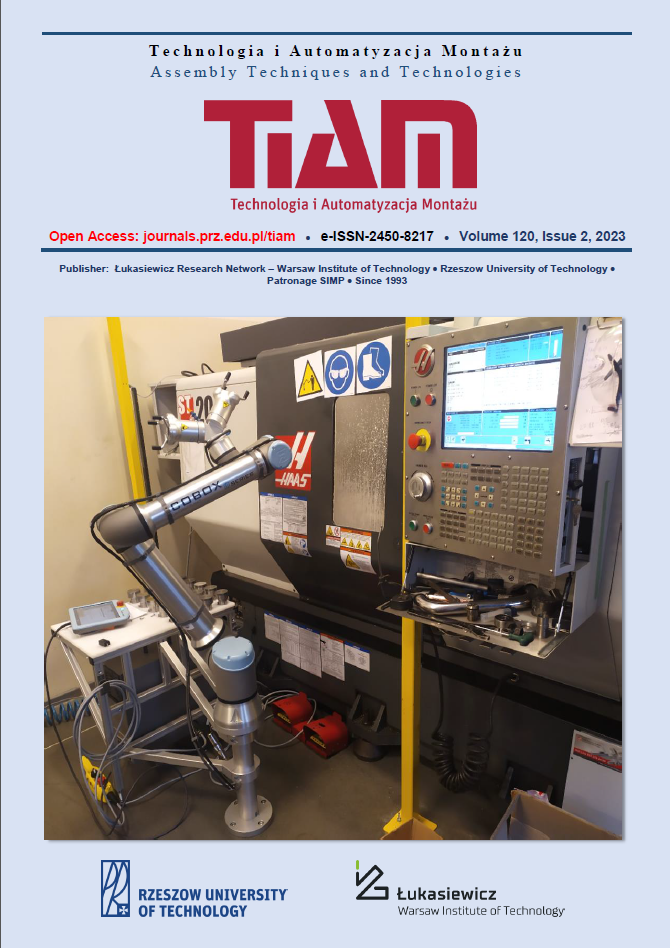Abstract
This paper gives a comparison of the deformation and deflection of two types of tool holders used in turning processes. Comparison of the deflection and stresses has been performed on the location where the highest value of deflection can be measured i.e. on the tip of the cutting insert. Selected tool holder types (TH1 and TH2) have rectangular and polygonal shank. Tool holders were 3D modelled in SolidWorks and Autodesk Inventor software packages and exposed to the loading with ANSYS structural analysis FEM software. In FEM analysis, two elements size of the network are selected (mesh size 5 and 1 mm). The simulation was carried out for five different loading values acting on the tool holder model. Obtained results confirm lower stresses and deflections on CAPTO tool holders.
This is an Open Access article distributed under the terms of the Creative Commons Attribution License CC BY 4.0 (https://creativecommons.org/licenses/by/4.0/)
References
Duan Xianyin, Peng Fangyu, Yan Rong, Zhu Zerum, Huang Kai, Li Bin. 2016. “Estimation of Cutter Deflection Based on Study of Cutting Force and Static Flexibility”. Journal of Manufacturing Science and Engineering, 138 (041001): 1-15.
Gasagara Amon, Jin Wujyin, Uwimbabazi Angelique. 2019.” Stability analysis for a single-point cutting tool deflection in turning operation”. Advances in Mechanical Engineering 11(6): 1–14.
Kalasua Vishrant, Tiwari Gaurav, Thakur Ankit. 2015. “Modelling of Single Point Cutting Tool Deflection due to Cutting Forces under Variable Side Rake Angle”. International Journal for Research in Applied Science & Engineering Technology, 3 (I): 2321-9653.
Kops Lukas, Gould Madelyn, Mizrach Michael. 1993. “Improved analysis of the workpiece accuracy in turning, based on the emerging diameter”. ASME Journal of Engineering for Industry, 115: 253-257.
Kops L, Gould M, Mizrach A, 1994. ”A search for equilibrium between workpiece deflection and depth of cut: key to predict compensation for deflection in turning” Manufacturing Science and Engineering ASME, 68(2):819–825.
Yang S, Yuan J, NiJ. 1997. “Real-time cutting force induced error compensation on a turning center” International Journal of Machine Tools and Manufacture. 37: 1597-1610.
Cloutier G, Mayer JR, Phan A-V.1999. “Singular function representation in obtaining closed-form solutions to workpiece deflections in turning multi-diameter bars”. Computer Modeling and Simulation in Engineering, 4: 133-137.
Phan AV, Cloutier G, Mayer J.R.R.1999. “A finite element model for predicting tapered workpiece deflections in turning” Computer Modeling and Simulation in Engineering, 4: 138-142.
Kiyak M, Kaner B, Sahin I, Aldemir J, Cakir O. 2010. “The dependence of tool overhang on surface quality and tool wear in the turning process” International Journal Advanced Manufacturing Technology 51 : 431–438.
Kowalik M, Rucki M, Paszta P, Gołębski R. 2016. “Plastic Deformations of Measured Object Surface in Contact with Undeformable Surface of Measuring Tool” MEASUREMENT SCIENCE REVIEW 16(5): 254-259.
PLATFORMA OBSLUGI NAUKI PLATON; URL: https://pcz.cloud.pionier.net.pl/, last accessed 2018/06/25.
ANSYS, Inc., Canonsburg, Pennsylvania. ANSYS Structural Analysis; URL: https://www.ansys.com/products/structures, last accessed 2018/06/25.


